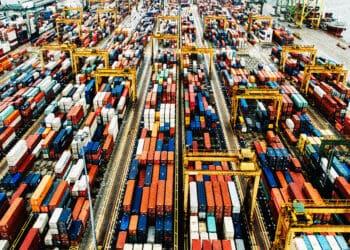Will ESG standards prove toothless if they don’t incorporate suppliers into the equation? That is the question investors, stakeholders and business leaders are asking as reporting mandates gain steam and come into effect around the world.
Consumers, investors, the public and lawmakers often ask: what use are exemplary ESG standards (relating to climate and environmental protection, workforce demographics and diversity, workforce health and well-being, cybersecurity and more) if respectable organizations still endorse (knowingly or unknowingly) bad practices within their supply chains?
High-profile events in the past decade have raised consciousness on the issue. In 2020, the Australian Strategic Policy Institute (ASPI) published a report identifying 83 foreign and Chinese companies benefiting from forced labor of Uyghur workers through abusive labor transfer programs. Leading technology brands have also hit the headlines when their practices of environmental infractions, such as the use of toxic materials, have come to light. Often, the main concern was the total absence of transparency, with accusations of secretive supply chain management in factories abroad.
Regarding climate specifically, McKinsey recently found that up to 90% of companies’ impact on the environment occurs in their supply chains. Such impacts can include toxic waste, water pollution, loss of biodiversity, deforestation, long-term damage to ecosystems, air emissions and excessive energy and water use. In the specific case of CO2 emissions, supplier operations can be responsible for 65-95% of a company’s total.
ESG in the Supply Chain: Lawmakers Are Taking Note
Any organization must therefore ask itself if it has the visibility required to do the necessary due diligence and ensure its suppliers are adhering to its own high standards. This has traditionally not been a concern for procurement professionals, who are judged on savings, technical quality, cost effectiveness, speed of delivery and reliability – not ESG compliance. We believe few companies today are pursuing ESG compliance simply because it’s morally the right thing to do; more often than not, they are motivated by profit, or in some cases, legislation requiring it to varying degrees.
In June 2021, the United States House of Representatives voted 215-214 to pass H.R. 1187, the “Corporate Governance Improvement and Investor Protection Act,” a compilation of several new company disclosures and related studies. If signed into law, the bill would amend the Securities Exchange Act of 1934 to require public companies to make potentially significant disclosures regarding ESG issues and would empower the SEC to define the parameters of such disclosures.
An amendment to H.R. 1187 by Congressman Dean Phillips of Minnesota would broaden its scope to require a large company to file annual reports with the SEC regarding its impact on “employees and contractors who are in its supply chain, communities it impacts, other stakeholders, the environment and other matters of common interest to citizens and relevant the social and natural systems.”
Europe Taking the Lead
Lawmakers are also acting internationally. Europe is taking the lead on supply chain due diligence. In Germany, a new law ratified on June 25, the Lieferkettenschutzgesetz – the supply chain law, could impose heavy fines if suppliers within companies’ supply chain are found to breach labor, human rights or environmental standards. The fines can go up to €800,000 or two percent of the company’s annual revenues if these exceed €400 million.
Germany’s Finance Minister, Olaf Scholz, explained the reasoning behind the law: “In future, it will be clear that ‘Made in Germany’ also means respect for human rights.”
The law is of international significance. Companies based or operating in Germany (irrespective of where they are legally registered) with more than 3,000 employees, or German-registered branches of foreign companies with more than 3,000 employees, must comply with the law from January 1, 2023. Companies with more than 1,000 employees must comply from January 1, 2024.
A similar law was enacted in France in 2017 and the Netherlands has a law specifically addressing child exploitation in the supply chain.
It is now likely that the German law will provide the basis for EU-wide legislation (in fact, that was the explicit intention of the German lawmakers). On March 10, the European Parliament adopted an outline proposal for the “EU Directive on Mandatory Human Rights, Environmental and Good Governance Due Diligence.” The European Commission has now been tasked with drafting a formal legislative proposal for this Directive to be presented to the European Parliament later this year and likely to come into force in 2023.
Germany should be applauded for being the first nation to extend comprehensive ESG reporting requirements to a business’ supply chain, even if only to immediate (Tier 1) suppliers. The German legislation does not (yet) require companies to actively monitor their Tier 2 suppliers and beyond.
Actions Organizations Can Take Now
Supply chains can run very deep and be very complex, and most organizations only have a direct relationship with the next level in the supply chain, known as Tier 1 or Top Tier suppliers. How can an organization influence what happens further along the chain?
The answer is by dangling carrots and, if necessary, wielding sticks.
Be crystal clear on your expectations: When it comes to dealing with Tier 1 suppliers, the duty falls upon contract managers to ensure that there is an obligation to understand and adhere to the buying organization’s own ESG standards. Supplier relationship managers need to be proactive in ensuring that these standards are adhered to in practice. Factory visits to Tier 1 suppliers are recommended.
Encourage Tier 1 suppliers to engage with those further down the chain, i.e. the Tier 2 suppliers: Procurement must impress upon primary suppliers that they have a duty to educate their own next-tier suppliers on the meaning of sustainability, business ethics and other ESG issues, and the benefits of compliance. This can extend to training and, in some circumstances, financial support to adjust business practices.
Reward compliant Tier 1 suppliers with opportunities to improve their own businesses: Make it clear that suppliers setting and enforcing ESG standards for their own suppliers will be rewarded. This can be done systematically, for example by weighting RFPs in their favor, or bonus schemes.
Consult with industry peers about their experiences: Take advantage of resources available that can provide a sense of industry peers’ own experiences in working with particular suppliers and understanding these suppliers’ level of commitment to ESG. Networking with peers can be a very effective way to understand a potential supplier’s ESG integrity.
Engage with governments and the broader community: Multinational organizations need to engage with governments and civil societies in those countries where their operations are based. Involvement with organizations such as the Extractive Industries Transparency Initiative (EITI) can facilitate such contacts – and will be a credit to any company’s own ESG standing.
Terminate contracts with suppliers that fail to meet your standards: Finally, the stick. Suppliers that fall short, or fail in their own due diligence, are a liability. Find alternatives and make it clear why you are doing so.
In terms of what the near-term future holds, we believe a fair amount of organizations won’t begin supply chain reporting unless it is mandated, though forward-thinking organizations will be more proactive (even if not totally driven by altruism and social consciousness). These organizations realize that public opinion, especially among younger generations, is making itself felt. Whether as investors or as customers, people increasingly want their money to follow their values – along the entire value chain. Commercial reasons for ESG aside, these organizations also realize delay puts them at risk of reputational damage and, coming soon, litigation.
In terms of how far down the tiers the requirements go, we don’t expect these to go beyond Tier 1 and Tier 2 suppliers any time soon. Engaging with suppliers beyond these levels is particularly challenging; unfortunately, the more upstream suppliers are in the supply chain (often in countries or regions with weak or unenforced labor laws), the less oversight and control organizations have over them.
However, much work needs to be done to increase transparency, traceability and influence over these upstream suppliers. In the meantime, it is entirely possible that organizations may structure their supply chains in such a manner that preferred suppliers (whose ESG compliance may not be verified) fall just outside the scope of regulations. While we hope that this does not occur, it may happen in a similar way that organizations take advantage of tax loopholes. However, if we remain vigilant, serious, high-profile supplier issues that come to light would require investigation to the fullest extent possible.
Today, ESG initiatives can be thought of as a positive and important movement. They are much more than the sum of reports by individual companies and organizations. In the modern economy, no organization is an island; on the contrary, it is just one hub in a global network of buyers and sellers. Whether motivated by legislation, commercial concerns or true social consciousness, an organization’s ESG record is judged not simply on its internal operations but on the entire supply chain it interacts with, and ESG initiatives must broaden in scope to address these concerns.



 Stephany Lapierre is the founder and CEO of TealBook, a highly coveted supply chain thought leader, and one of the most influential minds in emerging data technologies. She has been recognized as one of the Top 100 Most Influential Women in Supply Chain, and her company, TealBook, has both been named a Top 50 company to watch by Spend Matters and won the Cool Vendor Award by Gartner. Prior to TealBook, Stephany spent 10 years building a successful strategic sourcing and procurement consulting firm focusing on large scale sourcing optimization projects
Stephany Lapierre is the founder and CEO of TealBook, a highly coveted supply chain thought leader, and one of the most influential minds in emerging data technologies. She has been recognized as one of the Top 100 Most Influential Women in Supply Chain, and her company, TealBook, has both been named a Top 50 company to watch by Spend Matters and won the Cool Vendor Award by Gartner. Prior to TealBook, Stephany spent 10 years building a successful strategic sourcing and procurement consulting firm focusing on large scale sourcing optimization projects









